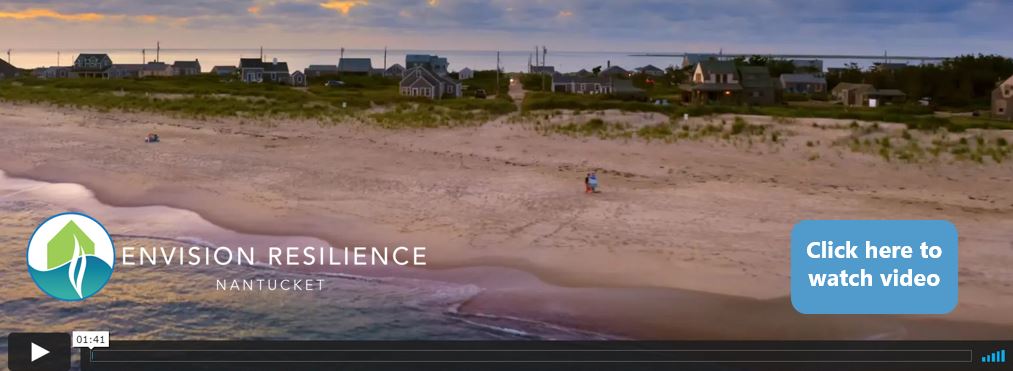Headline News Archive

People in every region of the world are increasingly seeing their health affected by climate change. Key trends seen in previous Lancet Countdown Reports are getting worse and exacerbating existing health and social inequities–the 2021 report gives a code red for health.
Check out the Lancet Countdown: Tracking Progress On Health and Climate Change 2021 Report to learn more about the relationship between health and climate change across five key domains and over 40 indicators.

The Florida Climate Institute’s Collaborative Climate Research Fellowship Program aims to provide opportunities for UF faculty to broaden their climate-related research scope and develop collaboration among the international faculty community. This fellowship helps foster the development of innovative, interdisciplinary research projects and publications that will help find solutions to the global, complex challenges facing society.
We are partnering again this year with the UF International Center’s Global Fellows Program to better connect our FCI climate fellow with a cohort of other early-career researchers.
Informational session:
Friday September 17, 2021 Noon to 1 pm (Large Conference Room, International Center – the Hub, 1765, Stadium Rd, Gainesville, FL 32611) or on Zoom https://ufl.zoom.us/j/7627585143
Funding:
A seed grant of $5,000 provides faculty an opportunity to lay the groundwork for conducting international climate-related research. Faculty must use these funds to cover expenses to travel to collect field data, to meet with international scholars, to access resources not available at UF, and to support any activity that advances climate research abroad.
Eligibility:
The program is open to all UF faculty who have a climate-related research assignment, regardless whether they are on a tenure track. The program is designed to support young scholars, those within the first 10 years of their academic career. In evaluating proposals, it is important for faculty to demonstrate that they have well thought out and clearly defined international research goals.
To apply:
Applications due October 21, 2021
In addition to the seed funding, the program offers a series of workshops, orientation and symposium that fellows must attend
- Application (no longer available)
- CV (3 pages max)
- Personal Statement of Interest (2 pages, 1-inch margins 11 – 12 pt. font)
- Letter of Support from Chair, Director, or Dean
- Letter of commitment from Mentor
Workshops
- Orientation: Friday, January 14, 2022, 1 – 3 pm
- Workshop 1: Friday, January 28, 2022, 9 – 11 am
Finding Funding to Support International Research - Workshop 2: Friday, February 11, 2022, 9 – 11 am
Preparing Proposals to Support International Research - Workshop 3: Friday, February 25, 2022, 9 – 11 am
Navigating the IRB, Export Controls, International Permits and Other Bureaucratic Hurdles - Workshop 4: Friday, March 18, 2022, 9 – 11 am
Broader Impacts – Measuring Scientific Merit and Impact on Society, Education and Outreach - Workshop 5: Friday, April 1, 2022, 9 – 11 am
International Partnerships and Agreements - Workshop 6: Friday April 15, 2022, 9 – 11 am
Engaging Students and Internationalizing the Curriculum, Study Abroad, Experiential Learning and More - Symposium: Friday, April 22, 2022, 9 am – 1 pm
· Complete an international research trip within one year.
· Identify and meet with an on-campus mentor who will provide guidance related to pursuing the international research project and other professional development endeavors during the program and beyond.
Previous fellows include:
2017-18: Stephanie Bohlman, UF School of Forest Resources and Conservation
In March 2018, Dr. Bohlman traveled to Panama to work with collaborators at the Smithsonian Tropical Research Institute on a manuscript using unmanned aerial vehicles to measure how tropical tree phenology responds to seasonal and interannual climate variation, developed an NSF proposal titled “Patterns, mechanisms, and consequences of variation in tropical forest plant phenology among species and environments in response to climate change” and presented two seminars: one on tropical tree phenology response to climate and environment, the other on using remote sensing to measure tree growth including response to growth to interannual climate variation.
2018-19: Jiangxiao Qui, UF School of Forest Resources and Conservation, Fort Lauderdale REC
In 2019, Dr. Qui worked to better understand and predict how global change drivers including climate change affect human-dominated landscapes (agriculture and urban) and their consequences for ecosystem services (ES) that are vital for human welfare. He focused on effects of multiple drivers of change (e.g., climate, land use/cover) and their interactions, and how purposefully altering and managing landscapes could buffer against undesirable future climate changes. Hence, understanding climate change impacts, and addressing climate adaptation and mitigation was the centerpiece of this research.
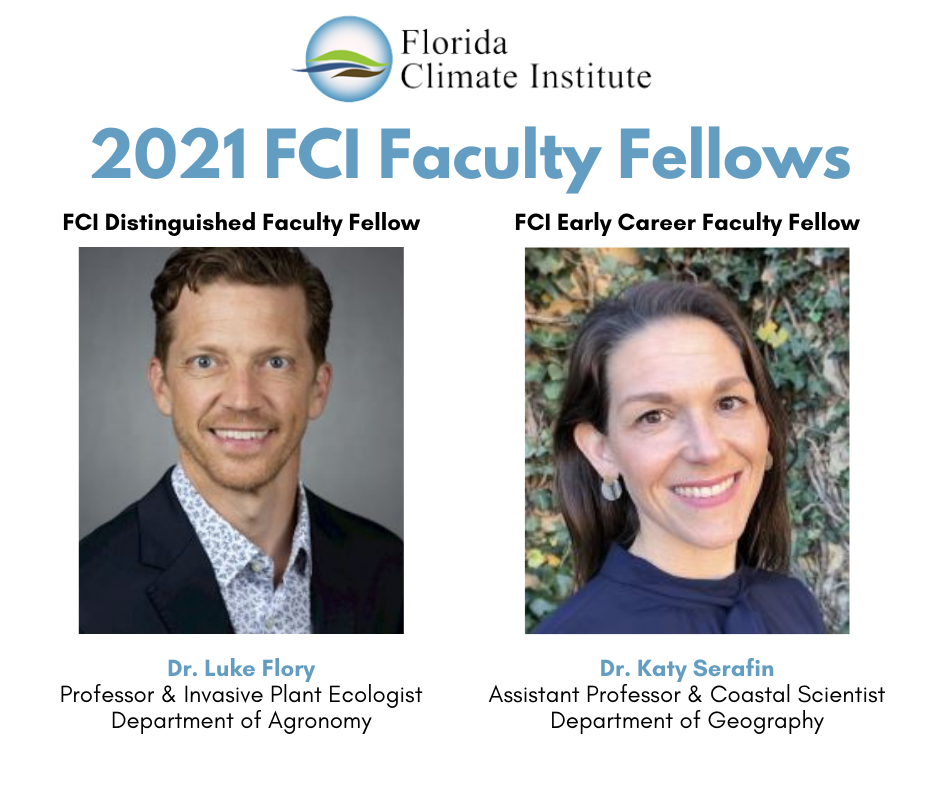
Congratulations to Dr. Luke Flory, Professor and invasive plant ecologist in the Department of Agronomy, for his selection as 2021 Florida Climate Institute Distinguished Faculty Fellow and Dr. Katy Serafin, Assistant Professor and coastal scientist in the Department of Geography, for her selection as 2021 UF Early Career Florida Climate Institute Faculty Fellow!
These awardees are being recognized for their outstanding contributions to interdisciplinary climate research, extension, and education programs, as well as their strong support of Florida Climate Institute Programs.
Dr. Luke Flory joined the Agronomy Department in 2011 as an invasive plant ecologist and has had remarkable achievements, an expanding national and international reputation as an expert and leader in invasive species ecology. He is responsible for investigating the mechanisms behind non- native species invasions, quantifying their ecological impacts, and examining how invasive species interact with other global change drivers such as climate change, emerging pathogens, and fire. Dr. Flory’s focus on invasion ecology is addressing one of the most critical problems faced by the state of Florida, the US, and the world.
Dr. Katy Serafin joined UF Geography in 2019 and over the past few years, her research has advanced the understanding of how processes such as waves, tides, and storm surge drive extreme coastal water levels in sandy beach and coastal river/estuarine environments. Investigation into the cascading impacts of sea level rise at UF by evaluating how the duration of nuisance or “sunny day” flooding events which have the potential to disrupt daily routines and put added strain on the human-built environment have been changing here in Florida and across the United States.
Stayed tuned for details on the date and format of the 2021 Faculty Fellows Celebration to honor this year’s FCI Faculty Fellows along with Water Institute Fellows Drs. Jiangxiao Qiu, Early Career and Lisa Krimsky, Distinguished Fellow.

This article is from the Miami-Dade County website.
King Tides are the highest predicted high tides of the year. King Tides are technically called "perigean spring tides," but they occur in both the spring and fall seasons. In fact, the highest tides in southeast Florida occur in the fall, in part because the water is warmer and the seasonal winds drive water levels higher at that time of year.
When and where are the King Tides expected?
King Tides normally occur a few times per year and often cause nuisance flooding in coastal and low-lying areas. More severe flooding may result if King Tides coincide with bad weather conditions such as heavy rains, strong winds or big waves. However, sea level rise is causing these tides to happen more frequently, to last longer and extend further inland than in the past.
Based on the National Oceanic and Atmospheric Administration's tide predictions, King Tides will occur on the following dates in fall 2021:
- Sept. 9-11
- Oct. 5-11
- Oct. 20-21
- Nov. 3-9
- Dec. 2-7
Preparing for the King Tides
Most of the King Tide impacts are felt along the coast and in very low-lying areas near other water bodies. Residents who want to know which areas are impacted by the King Tides are encouraged to use the National Oceanic and Atmospheric Administration's Sea Level Rise Viewer. On this map you can zoom into Miami-Dade County or your neighborhood. When you click on the "flood frequency tab" you will see areas in red that are vulnerable to King Tide flooding.
Flooding can also obstruct access to roadways. If possible, move vehicles to higher ground before the King Tides begin and wash your vehicle down with fresh water after driving through salt water.
Additionally, follow these safety precautions:
- Do not walk through flood water if possible.
- If you do need to walk through flood waters follow good hygiene practices and wash your hands, clothes, and pets after.
- Do not drive through flooded areas - it is dangerous and can damage your vehicle. Find an alternative route.
- Boaters should be aware that high tides cause lower clearance under bridges - check the tide before leaving the dock.
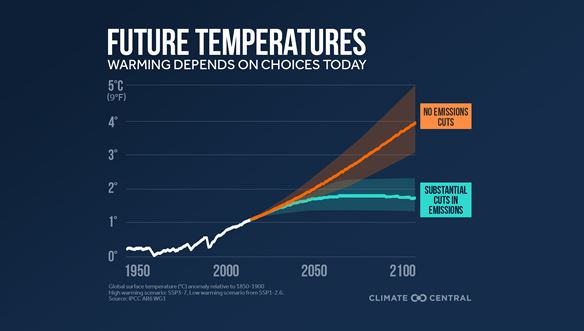 The Intergovernmental Panel on Climate Change (IPCC) released the first of three installments of the Sixth Assessment Report (AR6). The first installment is from Working Group I (WG1) and it discusses the physical science of climate change. Reports from Working Groups II (Impacts, adaptation, and vulnerability) and III (Mitigation of climate change) will follow in 2022.
The Intergovernmental Panel on Climate Change (IPCC) released the first of three installments of the Sixth Assessment Report (AR6). The first installment is from Working Group I (WG1) and it discusses the physical science of climate change. Reports from Working Groups II (Impacts, adaptation, and vulnerability) and III (Mitigation of climate change) will follow in 2022.
Part I of the new IPCC Sixth Assessment Report, The Physical Science Basis, updates the current scientific understanding of climate change, indicating that the impacts of climate change are largely happening the way scientists have expected. This report emphasizes the increasing confidence that scientists have that human activities increased CO2 concentrations and warmed and continue to warm our planet.
The full release, ready-to-use graphics, and other details can be found on the Climate Central website.
 States across the US are undertaking the work to understand what it will take to get to carbon neutral. These efforts support Biden’s plan of 100% clean electricity by 2035 and net-zero emissions economy-wide by 2050. The US Energy Information Administration reports that in 2017 Florida was the third largest emitter of carbon dioxide (www.eia.gov). To support this goal, the Florida Climate Institute (FCI) is undertaking work to develop a state-wide greenhouse gas inventory and initiate net-zero action planning.
States across the US are undertaking the work to understand what it will take to get to carbon neutral. These efforts support Biden’s plan of 100% clean electricity by 2035 and net-zero emissions economy-wide by 2050. The US Energy Information Administration reports that in 2017 Florida was the third largest emitter of carbon dioxide (www.eia.gov). To support this goal, the Florida Climate Institute (FCI) is undertaking work to develop a state-wide greenhouse gas inventory and initiate net-zero action planning.
Led by Florida International University and University of South Florida, university faculty and students from across the FCI, and stakeholders from across the State, are contributing expertise and research support in greenhouse gas inventory sectors of energy, industrial processes and product use, agriculture, land use, land-use change and forestry, including wetlands, and waste; Florida economic trends; and negative emissions technologies (e.g., direct air capture, geological sequestration, BECCS, agricultural soils, blue carbon). As part of the project, we have awarded scholarships to seven graduate students affiliated with Florida International University, University of South Florida, University of Florida, Florida State University, University of Central Florida, and University of Georgia. The project is supported by the Environmental Defense Fund. A report is expected to be released in February 2022.
For more information, please contact This email address is being protected from spambots. You need JavaScript enabled to view it.or This email address is being protected from spambots. You need JavaScript enabled to view it..
 In temperate climates, mosquitoes are generally inactive during the winter because temperatures are too cold, but as climate change makes winters shorter and warmer, scientists want to know how these shifts might affect mosquito activity. A new UF study shows that mosquitoes can adjust to rapid changes in temperature, indicating that mosquitoes normally dormant during winter may become active year-round due to climate change.
In temperate climates, mosquitoes are generally inactive during the winter because temperatures are too cold, but as climate change makes winters shorter and warmer, scientists want to know how these shifts might affect mosquito activity. A new UF study shows that mosquitoes can adjust to rapid changes in temperature, indicating that mosquitoes normally dormant during winter may become active year-round due to climate change.
The study’s authors conducted experiments with mosquitoes collected in and around Gainesville, a North Central Florida city on the dividing line between subtropical and temperate climates. The researchers say that insights from this study can help communities better prepare for the impacts of climate change as they relate to mosquitoes, which spread diseases that affect humans and animals.
You can read more on this study on Samantha Murray's UF/IFAS blog post.

Carolyn Cox, Coordinator of the FCI, used her model for experiential courses in Florida to help design a 5-university challenge around sea level rise impacts to the island of Nantucket. Through the UF Preservation Institute Nantucket program partnership, the FCI was able to provide this opportunity for 18 students (14 from UF and 4 from U Miami) from Florida to travel to Nantucket to present their work to the community and partner universities. This collaborative model also enabled all teams to learn from each other’s approach, innovations, and areas of strength. FCI plans to use this multi-institutional model in additional Florida cities.
Students studying architecture, landscape design and urban sustainability at five East Coast universities (U Florida, U Miami, Northeastern, Yale, and Harvard) spent the past five months in a semester-long course developing innovative and adaptive designs and proposals for the island and its year-round and seasonal residents and visitors. Due to the pandemic, the students never set foot on the island. But through a robust academic curriculum, an impressive 10-week speaker series and the partnership of more than 20 local advisors, students truly came to understand the coastal, geological and cultural history of Nantucket as well as the value systems of the community. On June 2, the students presented their final designs to the community, in an event that will inspire coastal communities everywhere to imagine a resilient and adaptive future in the face of sea level rise. Visit the event website below to see designs posted soon.
Nantucket is one of hundreds of U.S. cities and towns threatened by sea level rise. By 2100, much of Nantucket’s historic downtown is projected to regularly be inundated with as much as nine feet of water. Rather than run from rising seas, the Envision Resilience Nantucket Challenge called on teams of graduate and undergraduate students to design adaptive solutions for residents and businesses to learn to live with water.

On April 26, 2021, Florida Sea Grant's Coastal Planning Program Newsletter put out a special edition, Legislative Update on Resilience & Sea-Level Rise, to help make sense of some new legislation:
Florida Legislature Acts on Resilience, Sea-Level Rise, and Flooding but not on Climate Change; Sends Mixed Signals to Local Governments about Creating More Vulnerability
On April 8, 2021, the Florida Legislature passed “An Act Relating to Statewide Flooding and Sea Level Rise Resilience” (SB 1954/HB 7019) (referred to hereafter as the Resilience Act or Act). This and related bills contain a number of positive changes to Florida Statutes that will help Florida better understand the risks and costs to Florida of sea-level rise (SLR). While this and related bills that have passed this session, as described below, indicate a sea change for Florida’s Legislature on SLR, this effort would be stronger with a focus on the causes of SLR and increased flooding.
The Resilience Act clearly articulates the risks of SLR and increased flooding, whether due to more severe rain events, surge, or SLR. The Act establishes the “Resilient Florida Grant Program” in the Florida Department of Environmental Protection (DEP). The program can provide grants to local governments and regional resilience entities to fund resilience planning, vulnerability assessments for flooding and SLR, the development of adaptation projects, plans, and policies to address flooding and SLR threats, and projects to adapt critical assets to the effects of flooding and SLR. Grants may also be used for necessary data development and collection. The Act sets out minimum requirements for the data included in funded vulnerability assessments. Importantly, the Act requires that all such data be in specific formats and be submitted to DEP for inclusion in a statewide database.
This overall collection of local data will then assist the State accomplish the Resilience Act requirement that DEP develop a statewide flood vulnerability and SLR data set that will allow creation of a statewide flood vulnerability and SLR assessment. This includes development of statewide SLR projections (which are noted to not supersede regionally adopted projections) by the State’s Chief Science Officer. The Act details an extensive list of information to include in the statewide vulnerability assessment, such as information from previous local vulnerability assessments which meet specified information protocols. The first assessment is due for completion on July 1, 2023 whereas the statewide dataset on which it is based is due July 1, 2022.
The Act requires DEP to develop a yearly Statewide Flooding and Sea Level Rise Resilience Plan on a 3-year planning horizon. This plan consists of ranked projects that address flooding and SLR in coastal or inland communities and is submitted to the Governor and Legislature. The Act details the criteria and ranking percentages to be used by DEP in ranking the projects submitted by municipalities, counties, or regional resilience entities.
The Act establishes the Florida Flood Hub for Applied Research and Innovation at the University of South Florida College of Marine Science. The Hub is to coordinate and support applied research and innovation and to address flooding and SLR challenges in Florida. The Florida Flood Hub and USF serve as the lead institution for engaging other academic and research institutions, private partners, and financial sponsors on related efforts. Related bill SB 2514 authorizes DEP to provide funding to USF for operational and administrative costs for the Flood Hub.
Section 3 of the Act adds “inland and coastal flood control” to the Office of Economic and Demographic Research’s required annual assessment of Florida’s water resources and conservation lands.
The Resilience Act forms part of a larger initiative by the 2021 Legislature in Florida to address flooding and SLR. For example, the focus on specifying the types and formats of data to be collected and used and submitted to DEP for use at the state level is part of a larger effort by the State of Florida to capture more granular, local-level data on risk and vulnerabilities and the costs to address them. For example, HB 53 contributes to this, albeit on a shorter timescale, with wastewater and stormwater. HB 53 would require counties, municipalities, and special districts to develop detailed analyses and plans for their wastewater and stormwater facilities over the next 20 years. These analyses and their data sets are then compiled by the relevant counties and supplied to the State Office of Economic and Demographic Research. Additionally, HB 53 would have this information integrated into the new statewide assessment that is part of SB 1954.
Seeing Florida’s Legislature getting serious to address the impacts of flooding and SLR is good news. But is this sufficient?
First, and central to the entire conversation, neither SB 1954 nor any related bills directly address climate change (CC) as the driver for SLR and the increased intensity rain events causing increased inland and coastal flooding. This represents a failure to address the root causes of SLR and increased flooding. This is akin to a homeowner with a roof leak collecting data on how much water is leaking in, predicting where water might leak next, and estimating how many buckets and of what size are needed in the future. But doing all this without directly addressing the leaking roof. While we have already “baked in” some sea-level rise into our future, we still must reduce greenhouse gases to minimize the increasing rate of SLR and the total amount of SLR we cause by emitting greenhouse gases.
Second, legislative work on SLR so far focuses on infrastructure fixes to SLR and increased flooding. This may be a tenable approach in the short term, but over medium- and long-term time horizons, this will not be feasible for all communities. As Monroe County (a.k.a. the Florida Keys) has discovered with extensive data gathering and analysis in its efforts to understand the vulnerability of its roads: raising all the roads to keep them as dry as people are accustomed to will be too expensive for the County to maintain over the long-term. Similar realities will arise in other low-lying places for existing infrastructure beyond just roads. Fortifying infrastructure to address SLR and precipitation-driven increases in flooding buys us time, but we still need longer-term strategies and options. For example, when do we consider the merits of hardening infrastructure now versus investing those funds in planning for alternative solutions at the community level? Questions such as this admit of no easy answers, but sooner or later we will have to answer such difficult questions. The sooner we begin to consider them, the more options we will have and at costs we are more likely to be able to bear.
Third, the Resilience Act is linked financially to SB 2521 and SB 2514, both of which have now passed the Legislature. SB 2521 reduces the documentary tax stamp moneys that flow to the State Housing Trust Fund. Florida already has severe housing affordability problems. SLR and flooding exacerbate these challenges by driving gentrification in higher elevation areas in urban areas, with the Miami area often referenced as an example. Thus, even as SLR and increased flooding contribute to affordable housing problems, SB 2521 redirect monies from the State Housing Trust Fund to the “Resilient Florida Trust Fund” created by SB 2514 that will pay for the Resilience Act. Instead of directly addressing affordable housing, these monies will now be used to fund the new programs in SB 1954, such as the Resilient Florida Grant Program, the Statewide Flooding and Sea-Level Rise Resilience Plan, providing grants to regional resilience coalitions, and for administrative and operational costs of the Florida Flood Hub.
Fourth, even as the Legislature focuses on data gathering and funding projects to address SLR and increased flooding, the Legislature is sending mixed signals to local governments. To understand these mixed signals, a little background: those working in the fields of SLR and flooding understand three basic things: 1) Most of the risk from SLR and flooding comes from how and where we choose to develop (to paraphrase a famous quote: Floods are acts of God; flood losses are largely acts of people); 2) while individuals suffer greatly when disasters strike vulnerable areas, the public also pays the bill through massive federal spending to address the foreseeable damage that occurs due to our development decisions in hazardous areas (e.g. hundreds of billions of dollars in federal supplemental spending over the last years for disasters and forgiveness of tens of billions of dollars of debt of the National Flood Insurance Program); and 3) the most powerful tools local governments have to avoid creating more vulnerabilities to hazards such as SLR and flooding include planning, zoning, and development restrictions/conditions.
Yet even as these three points are clear, moving rapidly through the legislative process is SB 1876, an Act Relating to Relief from Burdens on Real Property Rights. This bill proposes significant changes to the Bert J. Harris, Jr., Private Property Rights Protection Act that would decrease the willingness and ability of local governments to make changes that prevent creation of more vulnerability (and the related public costs) in areas currently at risk of chronic flooding or that that will become so due to SLR and climate change. For example, SB 1876 would make it possible for property owners who have never applied for a permit, had any development plans, or maybe never even contemplated further development, to sue a local government for “damages” caused by the mere adoption of new rules or regulations on property. This could lead to attorneys watching for new local government and directing advertising to owners of “affected” properties. Since the bill also makes it easier for a prevailing property owner in a lawsuit to recover attorney’s fees (and for a longer time period) than for a prevailing defendant government, this bill would encourage more lawsuits that would decrease the willingness and ability of local governments—or the State—to slow or stop the creation of additional vulnerability to SLR and increased, climate-change-driven flooding. A number of other changes in the bill also place greater burdens and risks or offer less protections to government entities that might utilize planning, zoning, and development restrictions to prevent creation of more vulnerability to current and future risks. Thus, the proposed changes to the Bert Harris Act discourage any new rules or regulations through increased legal and financial risks to local governments of doing so. In turn, this means that property owners and developers will have more “rights” to create more of the very vulnerabilities that the Legislature is spending so much money to address in the Resilience Act.
In the past, Florida was a leader on land use planning and climate change mitigation through statewide policies focused on energy, conservation, and clean, renewable power. But most of those state laws have been repealed. Now, the Legislature has acted on some of the key impacts of climate change—increased flooding, higher storm surge, and SLR—but not the root causes of these impacts, all while advancing changes that make it more difficult for state or local government to avoid the private creation of additional vulnerability. The impacts of increasing vulnerability will, in large part, be borne by citizens and taxpayers at the local, state, and national levels.
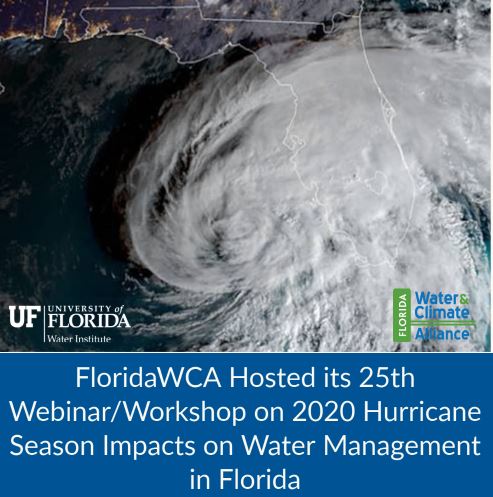 A record 137 participants joined a webinar on 2020 Hurricane Season Impacts on Water Management in Florida hosted by the Florida Water & Climate Alliance (FloridaWCA) and the UF Water Institute on April 7, 2021. It was the FloridaWCA’s 25th webinar/workshop since it was founded in 2010. Participants came from varied backgrounds and agencies including water utilities, Water Management Districts, government agencies, non-governmental organizations, universities and consulting firms.
A record 137 participants joined a webinar on 2020 Hurricane Season Impacts on Water Management in Florida hosted by the Florida Water & Climate Alliance (FloridaWCA) and the UF Water Institute on April 7, 2021. It was the FloridaWCA’s 25th webinar/workshop since it was founded in 2010. Participants came from varied backgrounds and agencies including water utilities, Water Management Districts, government agencies, non-governmental organizations, universities and consulting firms.
The webinar featured a panel session to discuss the 2020 hurricane season, impacts to utilities and water management districts, and the challenges associated with disaster and crisis communication in Florida related to climate change. Moderated by Dr. Vasu Misra (Florida State University) the session featured presentations by Dr. Tirusew Asefa (Tampa Bay Water), Dr. Michael Kozar (Risk Management Solutions), Dr. Angie Lindsey (University of Florida), and Dr. Carolina Maran (South Florida Water Management District). Additional webinar presentations featured two different projects that have the goal of co-producing climate science with stakeholders: Dr. Esther Mullens (University of Florida) presented on a national project to predict rainfall extremes at subseasonal to seasonal periods (PRES2iP); and Dr. Tracy Irani (University of Florida) presented on a Florida-specific project to improve seasonal forecasts for use in water utility decision making by integrating NASA earth systems data.
For Immediate Release: April 16, 2021
Contact: Governor’s Press Office, (850) 717-9282, This email address is being protected from spambots. You need JavaScript enabled to view it.
Lakeland, Fla. – Today, Governor Ron DeSantis announced that more than $148 million has been awarded to communities through the Florida Department of Economic Opportunity’s (DEO) Rebuild Florida Mitigation General Infrastructure Program. The program, administered by DEO, allows local governments to develop large-scale infrastructure projects to make communities more resilient to future disasters.
“My administration remains committed to providing the resources necessary for Florida communities to build back stronger and be more resilient to future storms,” said Governor DeSantis. “This transformational mitigation funding will go a long way in helping Florida’s communities invest in their futures through critical infrastructure improvements.”
“This Lake Bonnet project is a perfect example of government working well,” Representative Scott Franklin said. “It is a model for what success looks like in a public, private partnership that will help a needed community, clean up a lake ecosystem and provide a new park that the entire Lakeland community can enjoy. It is a shining example of government and the private sector at all levels, working together on behalf of our community. I applaud Governor DeSantis for his support of this project and thank everyone at every level who has supported the vision for this project and contributed to this momentous occasion.”
The funds are allocated to the state through the U.S. Department of Housing and Urban Development’s (HUD) Community Development Block Grant – Mitigation (CDBG-MIT) program formed in response to the 2016 to 2017 presidentially declared disasters.
“Under Governor DeSantis’ strong leadership, our state continues to provide investments to ensure the resiliency of Florida communities,” said DEO Executive Director Dane Eagle. “The Rebuild Florida Mitigation General Infrastructure Program provides storm-impacted communities the opportunity to complete large, high-impact infrastructure projects that will pay dividends for future generations.”
DEO is awarding the following communities funding through the Rebuild Florida Mitigation General Infrastructure Program:
- Broward County ($6,250,000) – to construct an interconnect between the Broward County Reuse Facility and the City of Pompano Beach's OASIS Reuse facility.
- City of Arcadia ($4,823,579) – to widen a stormwater tributary to provide additional storage during storm events to better control flood volume.
- City of Avon Park ($670,623) – to improve the existing potable water system through replacement of asbestos pipes with PVC piping, adding additional bore to improve water pressure, and to install an upgraded chlorine system.
- City of Doral ($1,000,000) - to reduce the frequency and severity of stormwater flooding by providing a positive-gravity drainage outfall discharging into the NW 58th Street canal.
- City of Fort Lauderdale ($10,500,000) – to replace aging and undersized stormwater infrastructure with new infrastructure systems that help with neighborhood flooding issues and provide better water quality treatment prior to releasing into the intracoastal waterway.
- City of Key West ($3,099,159) – to install tide valves at 40 stormwater outfall points of discharge to address saltwater flooding of roadways, sidewalks, and low-lying properties caused by high tides.
- City of Key West ($6,336,165) – to design and construct a pump-assist injection well to address flooding in a low-lying area that collects significant runoff.
- City of Lakeland ($42,986,390) – to establish a multi-component project in partnership with Bonnet Springs Park which focuses on increasing flood storage capacity to the drainage basin by improving the stormwater infrastructure and watershed quality.
- City of Lauderhill ($3,125,215) – to complete water and sewer line improvement projects.
- City of Miami ($13,497,843) – to retrofit portions of existing seawall, construct new sea wall sections, and other coastal resiliency improvements.
- City of Miami ($1,216,963) – to implement roadway resiliency improvements to NW 17th Street, between NW 27th Avenue and NW 32nd Avenue. Improvements include the installation of a drainage system, exfiltration trench, storm inlets, accessibility ramps, and swales.
- City of North Miami Beach ($6,000,000) – to implement system-wide improvements to the sewer collection system that protects public health and natural water resources.
- City of North Miami Beach ($11,700,000) - to enhance the water transmission and distribution system to improve water quality, fire flow capacity, reliability, and resiliency.
- City of Orlando ($2,850,000) – to develop six resiliency hubs that will provide services to low- and moderate-income communities in the recovery phase of a disaster.
- City of Sebring ($2,605,428) – to complete fire protection resiliency, water quality, and water conservation infrastructure improvements.
- City of Sebring ($3,515,580) – to harden facilities that are part of the cities sanitary sewer collection system.
- City of West Palm Beach ($16,764,610) – to build resilient seawalls, improve storm water quality, and develop living shorelines, pedestrian hardscaping, and native landscaping.
- DeSoto County ($3,757,012) – to replace decaying drainage system infrastructure to significantly increase service life and reduce the possibility of flooding.
- DeSoto County ($3,273,575) – to repair a bridge used as an evacuation route during storms.
- Osceola County ($4,689,320) – to modify and adapt existing drainage elements to substantially reduce repetitive flooding.
With a total allocation of $475,000,000, the Rebuild Florida Mitigation General Infrastructure Program will provide two additional rounds of funding in the future to communities designated by HUD or the state as Most Impacted and Distressed (MID) by Hurricanes Hermine, Matthew, and Irma.
The Department is the governor-designated state authority responsible for administering all U.S. Department of Housing and Urban Development (HUD) long-term recovery funds awarded to the state. Rebuild Florida uses federal funding for Florida’s long-term recovery efforts from the devastating impacts of natural disasters. For more information, visit RebuildFlorida.gov.
A team of scientists from the University of Florida hopes to address the invasive species problem by predicting how invasive species will move and migrate over the next 50 years as climate change, urbanization and other factors reshape the landscape.
Brett Scheffers, assistant professor at UF and the project’s principal investigator, said most of Florida’s invasive species are located in South Florida — but climate change and other trends could push these animals north.

CABI Agriculture and Biosciences is soliciting research manuscripts and novel contributions to a special collection entitled: Co-Benefits and Tradeoffs to Food Security from Mitigation and Adaptation in Agriculture
Special Collection Description:
Research at the nexus of climate mitigation and climate adaptation in agriculture remains challenging owing to both data and modeling limitations as well as the multi-scale analyses and stakeholder engagement required. Nevertheless, as the impacts of climate change intensify, there is an urgent need to close these science and policy gaps with rigorous analyses of how, and under what conditions, simultaneously pursuing agricultural adaptation and mitigation could provide valuable co-benefits and/or create trade-offs for food security, environmental change, and other important societal challenges. To fill these gaps, CABI Agriculture and Biosciences solicits high-quality manuscripts on (but not limited to):
• The data, models, and tools needed to evaluate agricultural mitigation and adaptation and subsequent co-benefits across biophysical and/or human (e.g., socio-economic) dimensions at multiple temporal and spatial scales
• Ongoing regional projects and case studies around the world that provide empirical bases to assess co-benefits stemming from combined mitigation and adaptation in agriculture
• Research addressing the socio-economic benefits and trade-offs, as well as the timescales of realizing mitigation and adaptation co-benefits
• Research on the science-policy links and policy implications of agricultural adaptation and mitigation co-benefits,
e. g., related to the development of national climate policies and commitments
The submission deadline is November 30, 2021
If the Legislature approves the new program, “Resilient Florida” will use revenues from the state documentary stamp tax to pay for the debt service on $1 billion in bonds for projects that address the impacts of climate change.
Climate by Powers of 10 tells the climate story visually in images, maps, and graphs. Using data from recent, peer-reviewed sources, the website tracks the full sweep of climate history and possible futures and makes the information accessible to students and general readers. Looking both back and forward in time by powers of 10, the website allows users to choose a timescale to enter, from the year-to-year pace of weather disruption to the hundred-thousand-year cycles of ice ages, and hundred-million-year age of oil deposits. Glimpses into the future draw on IPCC projections, to help readers imagine worst-case and best-case scenarios. Each stop offers an evocative glimpse of life at the time, stories about changes in human and non-human life, a map, and a graph of key indices from that timescale to the present, for example over decades, centuries, millennia, or millions of years.
The website offers an entry into climate data for those just learning about the crisis we face, as well a ready, visual reference for those already familiar with the contours of the climate situation. Readers are invited to enter at any point in the narrative, compare maps and graphs across timescales, and to find their own way toward a meaningful understanding of the data.
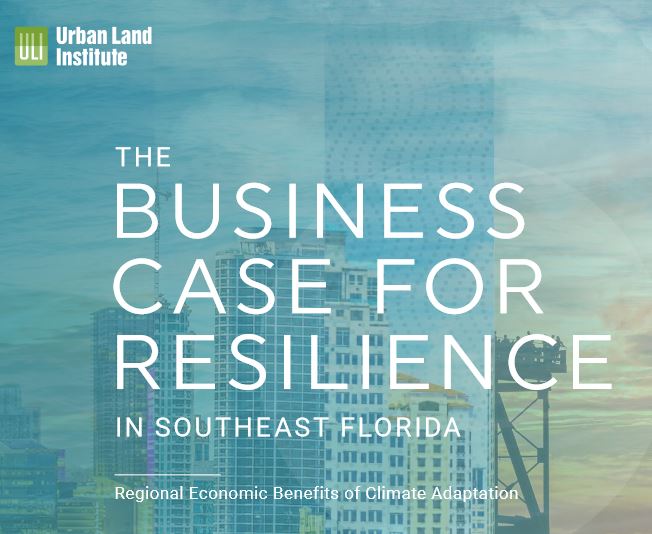 From the Miami-Dade County Office of Resilience:
From the Miami-Dade County Office of Resilience:
The Urban Land Institute (ULI) released a new report, The Business Case for Resilience in Southeast Florida: Regional Economic Benefits of Climate Adaptation. This cost-benefit analysis examines the economic risk of sea level rise in communities of the Southeast Florida Regional Climate Change Compact, including Miami-Dade, Broward, Palm Beach and Monroe counties. Based on a technical study completed by AECOM, one of the world’s leading infrastructure consulting firms, the report explicitly outlines the economic wisdom for significant public and private investment in resilient infrastructure now to prevent much more costly expenses in the future if no immediate action is taken. These investments will protect property against flooding while robustly driving job creation.
Economic hardships from potential dramatic declines in property values, damage from flooding, and lost tourism and tax revenue will amount to billions of dollars if steps are not taken now to transform our communities. However, the return on investment (ROI) from adaptation is positive, especially in Miami-Dade County. Building-level adaptations such as floodproofing, elevation, and the addition of permeable surfaces will generate $9 for every $1 invested and support 3,190 job years, which is one job per person each year, through 2040, or 22,660 job years through 2070. Community-wide adaptations, including green infrastructure, sea walls, and dune enhancement, will generate $5 for each $1 invested and support 15,200 job years through 2040, or 24,750 through 2070.
This ULI study supports the forthcoming Miami-Dade County Sea Level Rise Strategy, which will provide a clear roadmap for Miami-Dade County to make smart investments in resilience that create jobs and safeguard our community from future losses.
The ULI study was spearheaded and funded by a coalition of public and private partners, including Miami-Dade, Broward, Monroe, and Palm Beach counties; the Florida Department of Environmental Protection; the Beacon Council Foundation; Broward Workshop; Community Foundation of Broward; Greater Fort Lauderdale Chamber of Commerce; and Greater Miami Chamber of Commerce.
The Federal Emergency Management Agency (FEMA) announced a new policy that encourages communities to use environmentally friendly features such as wetlands for flood protection in addition to more traditional hard infrastructure like sea walls and levees. This new policy recognizes the value of natural and nature-based solutions for enhancing a community's resilience to flooding.
The new FEMA flood policy, released in September, eliminates the legacy benefit-cost ratio threshold requirement and allows ecosystem service benefits to be considered in all types of mitigation projects, regardless of the benefit-cost analysis value.
Read more about these changes in an article published by E&E News here.
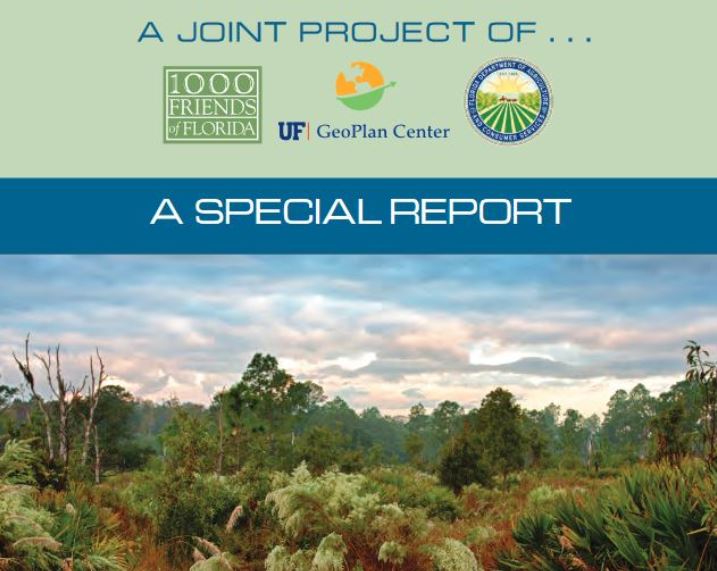 A team of faculty, staff, and students from the UF College of Design Construction and Planning, 1000 Friends of Florida, Florida Conservation Group, and Bureau of Business and Economic Research recently received funding from the Florida Department of Agriculture and Consumer Services for an update to the Florida 2070 Project, originally created by faculty emeriti Dr. Paul Zwick and Peggy Carr in collaboration with 1000 Friends of Florida. The update will identify a set of future growth scenarios for the State of Florida, which incorporate future sea level rise and population growth projections by the year 2070. For more information please contact Michael Volk (This email address is being protected from spambots. You need JavaScript enabled to view it.) or Dr. Tom Hoctor (This email address is being protected from spambots. You need JavaScript enabled to view it.).
A team of faculty, staff, and students from the UF College of Design Construction and Planning, 1000 Friends of Florida, Florida Conservation Group, and Bureau of Business and Economic Research recently received funding from the Florida Department of Agriculture and Consumer Services for an update to the Florida 2070 Project, originally created by faculty emeriti Dr. Paul Zwick and Peggy Carr in collaboration with 1000 Friends of Florida. The update will identify a set of future growth scenarios for the State of Florida, which incorporate future sea level rise and population growth projections by the year 2070. For more information please contact Michael Volk (This email address is being protected from spambots. You need JavaScript enabled to view it.) or Dr. Tom Hoctor (This email address is being protected from spambots. You need JavaScript enabled to view it.).


